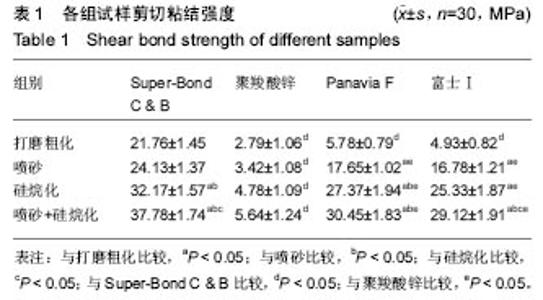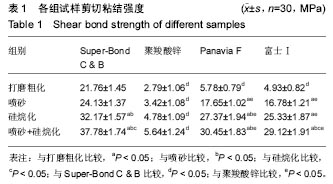| [1]钟恬,胡道勇,江燕,等. 5 种表面处理对氧化锆瓷与自粘接树脂水门汀间粘接强度的影响[J]. 实用口腔医学杂志, 2013, 29(1): 31-35.[2]钟瑾,赵莉,王晓东,等. 3 种粘接材料与氧化锆陶瓷粘接抗剪切强度的比较[J]. 广东牙病防治,2013,21(8):397-400.[3]张磊,胡书海. 氧化锆全瓷冠粘结方法的研究进展[J]. 大连医科大学学报,2010,32(2):215-218.[4]徐雄均,卢惠冰,李思萍,等. 三种树脂粘接剂对氧化锆陶瓷粘接剪切强度的影响[J]. 临床医学工程, 2013,20(10):1218-1219.[5]吴文桢,张昀,张卫平,等. CAD/CAM 二氧化锆全瓷冠在口腔修复中的应用 [J]. 卫生职业教育,2014,32(1):151-152.[6]孙凤,张桂荣,张峰,等. CAD/CAM 氧化锆全瓷在口腔修复领域的应用[J]. 上海口腔医学,2006,15(4):337-344.[7]杜桥,牛光良. 氧化锆的表面粗化和改性[J]. 国际口腔医学杂志, 2015,42(1):97-101.[8]龙红月. 氧化锆全瓷冠修复的临床应用研究[J]. 中国美容医学, 2008,17(11):1656-1658.[9]柳红芹, 朱国威. CAD/CAM 氧化锆全瓷冠在口腔修复领域中的应用研究[J]. 遵义医学院学报, 2011, 34(2): 190-193.[10]刘振海,张振庭,高卫民,等. 不同表面处理和不同粘结剂对氧化锆粘结强度的影响[J]. 北京口腔医学,2012,20(2): 61-63.[11]林艺华,宋晓萌,张玮. 3 种树脂加强型玻璃离子与氧化锆陶瓷粘接性能的研究[J]. 国际口腔医学杂志,2013,40(3):305-308.[12]李红霞,杜斌,刘劭晨,等. 不同表面处理方式对氧化锆与树脂水门汀粘接强度的影响[J]. 口腔颌面修复学杂志, 2015,16(2): 101-104.[13]纪忠海. 不同表面处理方式对氧化锆与树脂水门汀粘接强度的影响研究[J]. 中国医药指南, 2015, 13(31): 36.[14]刘振海,徐小川,高卫民,等.不同粘接剂及表面处理对氧化锆的粘接强度的影响[J].口腔颌面修复学杂志,2016,17(3):152-155.[15]陈珍香,罗和平,江燕,等. 不同表面处理和不同粘结剂对氧化锆粘结强度的影响[J]. 当代医学,2015,21(33):155-156.[16]陈启林,李娟,严艳,等. 不同粘接材料及表面处理方法对瓷与托槽粘结强度的影响[J]. 临床口腔医学杂志,2015,31(1): 6-9.[17]陈晨,谢海峰,宋鑫,等. 氧化锆处理剂和自粘接树脂水门汀对氧化锆陶瓷粘接的效果评价[J]. 华西口腔医学杂志, 2013, 31(5): 500-503.[18]高卫民, 刘振海, 张振庭, 等. 喷砂对不同粘接剂与氧化锆粘接强度的影响[J]. 北京口腔医学, 2007, 15(5): 245-247.[19]Saka M, Yuzugullu B. Bond strength of veneer ceramic and zirconia cores with different surface modifications after microwave sintering. J Adv Prosthodont. 2013;5(4):485-493.[20]Ozcan M, Vallittu PK. Effect of surface conditioning methods on the bond strength of luting cement to ceramics. Dent Mater. 2003;19(8):725-731.[21]Kitayama S, Nikaido T, Takahashi R, et al. Effect of primer treatment on bonding of resin cements to zirconia ceramic. Dent Mater. 2010;26(5):426-432.[22]Aboushelib MN, Kleverlaan CJ, Feilzer AJ. Selective infiltration-etching technique for a strong and durable bond of resin cements to zirconia-based materials. J Prosthet Dent. 2007;98(5):379-388.[23]Lv P, Yang X, Jiang T. Influence of Hot-Etching Surface Treatment on Zirconia/Resin Shear Bond Strength. Materials (Basel). 2015;8(12):8087-8096.[24]Kawai N, Lin J, Youmaru H, et al. Effects of three luting agents and cyclic impact loading on shear bond strengths to zirconia with tribochemical treatment. Journal of Dental Sciences. 2012;7(2): 118-124.[25]Blatz MB, Sadan A, Kern M. Resin-ceramic bonding: a review of the literature. J Prosthet Dent. 2003;89(3):268-274.[26]Atsu SS, Kilicarslan MA, Kucukesmen HC, et al. Effect of zirconium-oxide ceramic surface treatments on the bond strength to adhesive resin. J Prosthet Dent. 2006;95(6): 430-436.[27]Tsuo Y, Yoshida K, Atsuta M. Effects of alumina-blasting and adhesive primers on bonding between resin luting agent and zirconia ceramics. Dent Mater J. 2006;25(4):669-674.[28]Li R, Sun YC, Wang C, et al. Bonding of an opaque resin to silane-treated porcelain. Biomed Mater Eng. 2014;24(6): 2117-2125.[29]Li R, Zhou H, Wei W, et al. Effects of Mechanical and Chemical Pretreatments of Zirconia or Fiber Posts on Resin Cement Bonding. PLoS One. 2015;10(6):e0129690.[30]Li R, Sun C, Gao P. The effects of the macroscopic conditions of a ceramic primer with high bond durability in a silica-based ceramic. Materials Research Innovations. 2015; 19(S5): 1280-1284.[31]邵龙泉,胡琛,孙挺,等. 表面处理方法及黏结剂种类影响氧化锆的剪切强度[J]. 中国组织工程研究, 2012, 16(8): 1435-1438.[32]翁蓓军,李国强. 全瓷冠及其相关陶瓷粘接剂的研究与应用[J]. 中国组织工程研究,2011,15(29): 5449-5452. |

